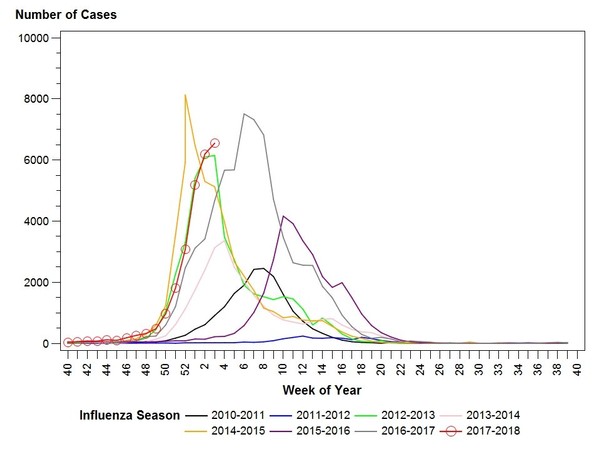2018 flu season brings another round of sickness and death

This chart shows the amount of flu cases in Pennsylvania during flu season since 2010. This graph is updated to week three of 2018.
Every fifty years, a strain of flu emerges that seems particularly aggressive. In 1918, the
H1N1 strain infected one-fourth of the world and killed 50 million people, which is less than the amount of death as a result of World War II, which had 17 million deaths. In 1968, the H3N2 “Hong Kong Flu”—named after where it started—killed nearly one million people. This year, the H3N2 strain is the dominant strain in those who are afflicted with the flu. Many worry that this year’s flu could bring the same devastating consequences that it has by continuing this trend of death.
So far, the flu vaccine for this year has only shown a 10 percent success rate. This is mostly because that the flu type that is circulating around the United States is H3N2—a particular strain that is mostly immune to the protectiveness of the flu vaccine.
This can mainly be attributed to chicken eggs. Within the flu vaccine, there is a weakened or inactivated form of the flu virus. Years ago, scientists discovered that the flu virus replicates itself especially well in eggs. However, here lies the problem. H3N2 is a strain of the flu virus that mutates and as it spreads across the population, it changes more and more. The same thing happens when it’s replicating in the eggs; it mutates and its number grows. As a result it’s harder for the vaccine to work against a virus that has changed.
In Beaver County, there has been a total 1,053 cases of the flu, which makes up for about 2.2 percent of the flu cases within Pennsylvania. By week five of 2018, there have been more flu cases than the past eight years.
In Pennsylvania, there has been a total of 91 flu-related deaths as of Feb. 6. Of those, the majority of victims were age 65 or older and only two of them were under the age of 18. Along with this, a total of 53 youths have died as a result of contracting the flu. Already, this has exceeded half of the total children death in 2017, which totaled 101 deaths.
With the flu season in full swing, parents look for ways to help their children with the flu. For some, they turn to medications like Tamaflu. However, many of these medicines, like Tamaflu, have dangerous side effects.
For instance, parents who have given their children Tamiflu have reported them jumping out of buildings, having seizures and rashes appearing on their childs’ skin. Additionally, Charlie Harp, a 16-year-old in Indiana, took his life, to which his parents said was because of a side effect of Tamaflu. Doctors have since said that this happening is very unlikely.
“So there is a warning with the medication about these potential problems. So physicians prescribing it have to keep that in mind. Also it’s important to keep that in mind that the benefit of the medication when treating generally outweighs the potential risks,” Dr. James Ireland, a physician who practices at the John A. Burns Medicine School said.
According to the Center for Disease Control and Prevention (CDC), preventing the flu is as easy as six simple things: avoid close contact, stay home when you’re sick, cover your mouth and nose when you sneeze and cough, clean your hands, practice good health habits and avoid touching your eyes, nose and mouth. These precautions can lead to the H3N2 strain of the flu eventually dying out.


